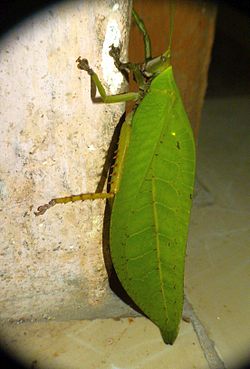Systematics The Pseudophyllinae may be subdivided into the following tribes (the first 17 of which are sometimes grouped into the super-tribes: Pleminiiti and Pseudophylliti) and genera . [ 2] Some notable species are also listed here:
Aphractini Auth.: (Brunner von Wattenwyl 1895) - Chile
Callimenellini Auth.: (Gorochov 1990) - Asia: including India, Indo-China and the Philippines
Cocconotini Auth.: (Brunner von Wattenwyl 1895) - Central and southern America
Beierotettix Özdikmen, 2007 Bliastes Stål, 1873 Bliastonotideus Beier, 1962 Bliastonotus Beier, 1960 Brachybliastes Beier, 1960 Calamoptera Saussure, 1861 Chrysobliastes Beier, 1960 Cobalotettix Beier, 1962 Cocconotus Stål, 1873 Cojedebius Kevan, 1989 Diplopygia Beier, 1962 Docidocercus Beier, 1960 Eubliastes Beier, 1960 Geonotus Beier, 1960 Helicocercus Beier, 1960 Idiarthron Brunner von Wattenwyl, 1895 Incanotus Beier, 1960 Jamaicoecia Beier, 1962 Leiobliastes Beier, 1960 Liparoscelis Stål, 1873 Liparoscella Hebard, 1933 Melanonotus Brunner von Wattenwyl, 1895 Meroncidius Serville, 1831 Mystron Montealegre-Z. & Morris, 1999 Nannonotus Beier, 1960 Nannotettix Redtenbacher, 1895 Nastonotus Bolívar, 1890 Natagaima Beier, 1960 Nesoecia Scudder, 1893 Nesonotus Beier, 1960 Schedocentrus Hebard, 1924 Sphaeropyga Beier, 1960 Stenotettix Stål, 1873 Thamnobates Saussure & Pictet, 1898 Trichotettix Stål, 1873Cymatomerini Auth.: (Brunner von Wattenwyl 1895) - Central Africa and Asia: including India, Indo-China, Malesia and the Philippines
Sanaa regalis Tegra novaehollandiae Cymatomera Schaum, 1853 (Africa) Cymatomerella Beier, 1954 (Africa) Olcinia Stål, 1877 Parasanaa Beier, 1944 Platenia Dohrn, 1888 - monotypic Platenia semialata (Philippines) Sanaa Walker, 1870 Sathrophyllia Stål, 1874 Sathrophylliopsis de Jong, 1939 (W. Malesia ) Tegra Walker, 1870 Tegrolcinia de Jong, 1939 (China, W. Malesia) Typhoptera Kirby, 1906Eucocconotini Auth.: Beier 1960 - Central and South America
Panoploscelis specularis Homalaspidiini Auth.: (Otte, D. 1997) - Southern America
Ischnomelini Ischnomela gracilis Auth.: (Beier 1960) - Southern America
Leptotettigini Auth.: (Beier 1960) - Southern America
Pantecphylini Auth.: (Brunner von Wattenwyl 1895) - Central Africa
Phyllomimini Phyllomimini Auth.: (Brunner von Wattenwyl 1895) - West and central Africa; Australasia: India through to Pacific islands
Acanthoprion Pictet & Saussure, 1892 Acauloplacella Karny, 1931 Acauloplax Karsch, 1891 Brochopeplus Pictet & Saussure, 1892 Brunneriana Uvarov, 1923 Chondrodera Karsch, 1890 Chondroderella Hebard, 1922 Despoina Brunner von Wattenwyl, 1895 Diplodontopus Karny, 1931 Gonyatopus Brunner von Wattenwyl, 1895 Hapalophyllum Hebard, 1922 Hemigyrus Brunner von Wattenwyl, 1893 Heteraprium Krauss, 1903 Lacipoda Brunner von Wattenwyl, 1895 Lagarodes Karsch, 1890 Margarodera Beier, 1957 Mioacris Pictet & Saussure, 1892 Morsimus Stål, 1877 Orophyllus Beier, 1954 Paramorsimus Beier, 1954 Paraphyllomimus Beier, 1954 Phyllomimus Stål, 1873 Phyllozelus Redtenbacher, 1892 Pirmeda Henry, 1940 Promeca Brunner von Wattenwyl, 1895 Pseudacanthoprion Beier, 1954 Pseudophyllomimus Karny, 1924 Rhinodera Beier, 1955 Stenampyx Karsch, 1890 Stizoscepa Karsch, 1896 Temnophylloides Henry, 1939 Temnophyllus Redtenbacher, 1895 Timanthes Stål, 1877 Tomias Karsch, 1890 Tympanophyllum Krauss, 1903 Tympanoptera Redtenbacher, 1892 Zumala Walker, 1869Platyphyllini Xiphophyllum sp. Auth.: (Brunner von Wattenwyl 1895) - Southern America
Acyrophyllum Beier, 1960 Aemasia Brunner von Wattenwyl, 1895 Antillophyllum Beier, 1960 Baliophyllum Beier, 1962 Brachyauchenus Brunner von Wattenwyl, 1895 Choeroparnops Dohrn, 1888 Diyllus Stål, 1875 Drepanoxiphus Brunner von Wattenwyl, 1895 Haenschiella Beier, 1960 Kopis Beier, 1960 Myrmeciophyllum Beier, 1960 Opetiocercus Beier, 1960 Platyphyllum Serville, 1831 Rhabdotophyllum Beier, 1960 Triencentrus Brunner von Wattenwyl, 1895 Xiphophyllum Beier, 1960Pleminiini Auth.: (Brunner von Wattenwyl 1895) - Central and southern America, West and central Africa
Championica cristulata in Costa Rica Batodromeus subulo Acanthodis Serville, 1831 Acanthorhinischia Beier, 1954 Adapantus Karsch, 1891 Adeclus Brunner von Wattenwyl, 1895 Adenes Karsch, 1891 Amiltonia Piza, 1976 Ancistrocercus Beier, 1954 Anonistus Walker, 1871 Apereisis Walker, 1871 Aspidopygia Beier, 1962 Balboana Uvarov, 1939 Batodromeus Karsch, 1896 Beieroschema Özdikmen, 2008 (formerly Colobotettix Beier, 1960 (non Ribaut, 1948: preoccupied ) ) Bufotettix Caudell, 1918 Championica Saussure & Pictet, 1898 Clepsydronotus Beier, 1954 Condylocnemis Redtenbacher, 1895 Corynecercus Beier, 1954 Dasyscelidius Beier, 1954 Dasyscelus Redtenbacher, 1895 Diacanthodis Walker, 1870 Enthacanthodes Redtenbacher, 1895 Gongrocnemis Redtenbacher, 1895 Habrocomes Karsch, 1890 Haemodiasma Brunner von Wattenwyl, 1895 Hoplidostylus Karsch, 1893 Jamaicana Brunner von Wattenwyl, 1895 Labidocercus Beier, 1954 Leurophyllidium Beier, 1954 Leurophyllum Kirby, 1906 Lichenochrus Karsch, 1890 Mormotus Karsch, 1890 Nesokatoikos Braun & Maehr, 2008 (formerly Nesocnemis Beier, 1954 (non Sélys, 1891: preoccupied ) ) Nesophyllidium Beier, 1954 Orpacanthophora Beier, 1954 Paradeclus Beier, 1954 Paralichenochrus Beier, 1954 Parapleminia Beier, 1954 Pedinothorax Beier, 1954 Phyllostachydius Beier, 1954 Pleminia Stål, 1874 Polyglochin Karsch, 1890 Pristonotus Uvarov, 1940 Pseudopleminia Beier, 1954 Rhinischia Beier, 1954 Schochia Brunner von Wattenwyl, 1895 Sphyrophyllum Beier, 1954 Stenoschema Redtenbacher, 1895 Tetragonomera Stål, 1874 Tympanocompus Karsch, 1891 Xerophyllopteryx Rehn, 1905Polyancistrini Auth.: (Brunner von Wattenwyl 1895) - Mexico, Caribbean, Southern America
Pseudophyllini Auth.: (Burmeister 1838) - West and central Africa; Asia: India, Indo-China through to Papua New Guinea
Onomarchus kanara Rhomboptera semilunata Cratioma sp. Zabalius cf. ophthalmicus Brunneana Uvarov, 1939 Chloracris Pictet & Saussure, 1892 Climacoptera Redtenbacher, 1895 Cratioma Bolívar, 1906 Desaulcya Bolívar, 1906 Liocentrum Karsch, 1890 Micta Karsch, 1896 Mustius Stål, 1874 Onomarchus Stål, 1874 Opisthodicrus Karsch, 1890 Oxyaspis Brunner von Wattenwyl, 1895 Perteus Bolívar, 1906 Pseudophyllus Serville, 1831 Rhomboptera Redtenbacher, 1895 Zabalius Bolívar, 1886 Pterophyllini Auth.: (Karny, 1925) – Americas
Caloxiphus Saussure & Pictet, 1898 Caribophyllum Rehn, 1947 Diophanes Stål, 1875 Elytraspis Beier, 1962 Karukerana Bonfils, 1965 Lea Caudell, 1906 Lophaspis Redtenbacher, 1895 Mastophyllum Beier, 1960 Paracyrtophyllus Caudell, 1906 Parascopioricus Beier, 1960 Phyllopectis Rehn, 1948 Pterophylla Kirby, 1825 Scopioricus Uvarov, 1940 Scopiorinus Beier, 1960 Thliboscelus Serville, 1838 Xestoptera Redtenbacher, 1895Simoderini Auth.: (Brunner von Wattenwyl, 1895) - Madagascar, Australia
Teleutiini Auth.: (Beier, 1960) - Panama to Southern America
Acanthodiphrus Walker, 1871 Apteroteleutias Beier, 1962 Beierella Piza, 1978 Brachyteleutias Beier, 1960 Chibchella Hebard, 1927 Eumecopterus Beier, 1960 Hoplotettix Caudell, 1918 Leptoteleutias Beier, 1962 Mylothrella Beier, 1960 Pemba Walker, 1870 Stetharasa Montealegre-Z. & Morris, 1999 Teleutias Stål, 1874Tribe undetermined Due to the great diversity of this subfamily, it is not unequivocally delimited yet.
This page is based on this
Wikipedia article Text is available under the
CC BY-SA 4.0 license; additional terms may apply.
Images, videos and audio are available under their respective licenses.














